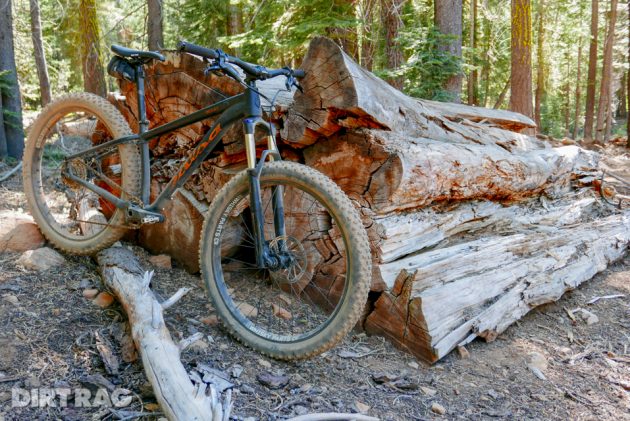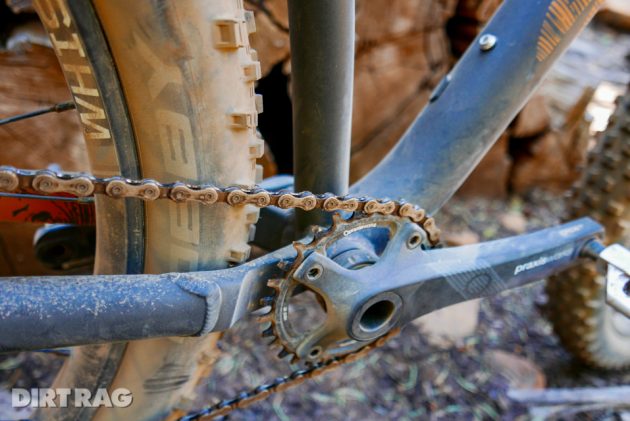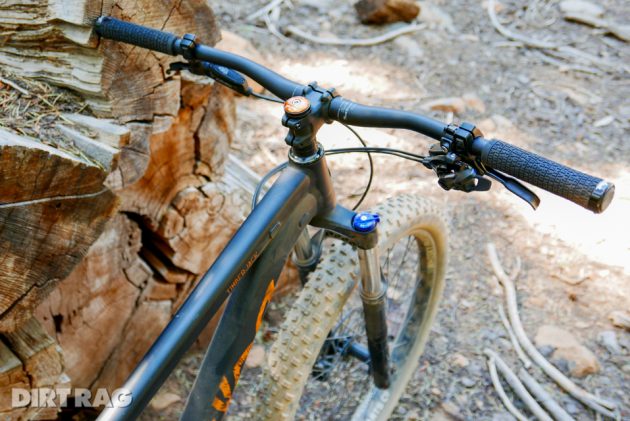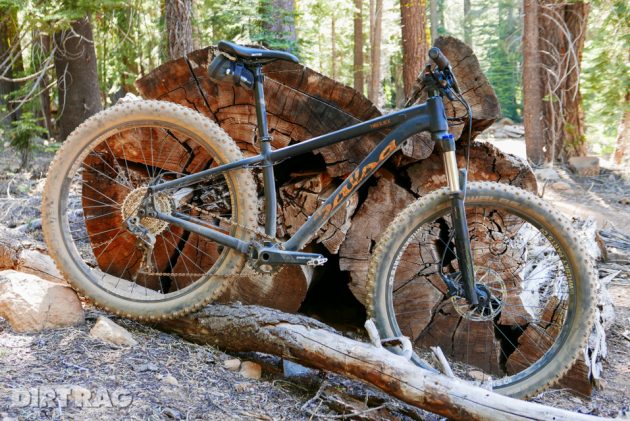First Ride: Salsa Timberjack 27plus
Originally posted on July 28, 2016 at 12:11 pm
Ed note: This is part of our initial bike test of three new hardtails introduced at QBP Saddle Drive 2016, each shod with 27plus tires: the aluminum Salsa Timberjack, carbon Salsa Woodsmoke and steel Surly Karate Monkey. Despite their obvious differences, we will draw some comparisons and distinctions among the three, so make sure to check out the other first ride reviews as we publish them.
The Timberjack arrives on the heels of the demise of the steel El Mariachi, a longtime singletrack-and-bikepack staple of the Salsa lineup. This new bike follows most current hardtail trends of more than 100 mm of travel, short chainstays and plus-size tires. By building the bike out of aluminum, Salsa created a machine friendlier on the wallet, lighter weight and perhaps less intimidating for a newer mountain biker/bikepacker to approach in their local bike shop (Salsa will also be sold by REI very soon).

Personally, I don’t fancy the way most aluminum bikes ride or look, especially hardtail mountain bikes. Despite being the youngest person on Dirt Rag’s staff, I am the resident steel-loving retrogrouch.
That said, it is hard to argue with what you can get for $1,400 (the test bike I rode): 120 mm of RockShox Recon SL suspension, 27.5×3.0 Schwalbe Nobby Nic tires, tubeless-ready Whisky (in-house QBP brand) rims, trail bike mannerisms, internal cable routing and a 30.9 seatpost size for greater compatibility with droppers (which also can be internally routed).
At that price point, and after a couple of hours romping in the woods together, I can’t think of a single bad thing to realistically say about the Timberjack.

My Saddle Drive test route on the slopes of Northstar at Tahoe went like this: climb up a long, dirt service road; rip around on some rolling, rooty cross-country singletrack; descend on rocky, dusty, intermediate DH trails.
My bike was set up with a wildly short stem (40 mm, I think) and tubeless tires (necessary). Despite the short, 420 mm-long chainstays on my size small, the Timberjack motored up that service road without complaint. It’s a little sluggish when you stand to hammer out of the saddle but if you are, like me, a sit-and-grind climber, the tire grip should please you.
The top tube is on the long side, helping to facilitate that short cockpit, so riders with short torsos might have a little trouble getting situated. It also meant I had a bit of a harder time getting my butt back behind the saddle on some of the gnarlier descents. I would absolutely add a dropper to this bike if it were to be ridden on steeps.

On the singletrack, the Timberjack was playful, confident, held its momentum decently well and generally rode a lot like its carbon sibling, the Salsa Woodsmoke (yes, really). Its stability and speed fell right in between the Woodsmoke and the new Surly Karate Monkey, the latter of which is more stable and assuring, the former snappier and easier to get silly on.
I did almost face plant off a wooden feature when I took it too fast to simply roll but wasn’t positioned correctly to get air. The big tires, brapping cockpit and whippy rear end means you can easily get out of hand on the Timberjack because you’re having too much fun and forget you lack a rear shock…

The bike held its own at speed, railed berms and stayed patient with me when I needed to slow way down to pick my way through bigger rock gardens that I didn’t feel I had the bike to just blast through.
These plus bikes are your bad-idea cousins. Take one down chunky trails without rear suspension? Sure, why not? Just stay light, stay back and bounce your way over those rocks with your fingers mentally crossed. The chain slap and general rattle of an aluminum bike does get a bit noisy through rock gardens and you can bottom out those low-pressure tires if you take it off too big of a drop, but, whatever. It’s also a sweet trail bike for your hometown singletrack.

It’s worth noting that plus bikes do ride differently than your standard 2.2-2.4 tire—you can’t straight compare all hardtails. You will feel a bit of sag if you run low pressures on long climbs (kind of like a rear shock in trail mode rather than climb or lockout). The noise those big meats make can sound like you actually have a flat because so much more rubber is contacting the dirt and gravel than you’re used to. You have to learn to block that out of you mind.
But all that contact equals grip equals fun times. That’s the deal with these 3-inch tires: confidence. They float over more chunk than you imagine is possible and they will claw you up and over all kinds of trail crud.
The Timberjack is a bargain at $1,400 and it’s one of the only bikes in this category available in extra small. Get yourself a used dropper post off Craigslist for $100 and you have yourself a really nice trail bike at a really nice price.
See full geometry and build-kit specs on Salsa’s website.

The aluminum 27plus bike category
The Specialized Fuse was a big player in kicking off this category a year ago and the entry-level aluminum model comes close to the Salsa at $1,600—that $200 difference gets you a dropper post. As much as I love droppers, I think the new SRAM GX/NX spec on the Timberjack works better than the SRAM X7/X5 build the Fuse gets.

Also in the aluminum 27plus bike family (around the Timberjack’s price point) are the following:
- Kona Big Kahuna at $1,400 (100 mm fork, Shimano Deore, 440 mm chainstays, 69-degree headtube angle)
- Cannondale Beast of the East 3 at $1,600 (120 mm fork, Shimano SLX, 435 mm chainstays, 68.4-degree headtube angle)
- Scott Scale 720 Plus at $1,700 (120 mm fork, Shimano Deore, 439 mm chainstays, 67.7-degree headtube angle)
- Norco Torrent 7.2 at $1,450 (12o mm fork, Shimano Deore/SLX, 422.5 mm chainstays, 67-degree headtube angle).
All stats are from each bike’s size medium.
The Fuse is the only one with a dropper; all of the bikes wear decent tires and hydraulic disc brakes. We really liked the slack Torrent 7.2’s nicer and more expensive brother, the Torrent 7.1 (read our review of that bike).
I’m personally stoked to see this category growing. For someone who wants just one bike to do many things but doesn’t have a wallet fat with Benjamins, this is one type of mountain bike they should closely consider, and the Salsa is a strong contender.